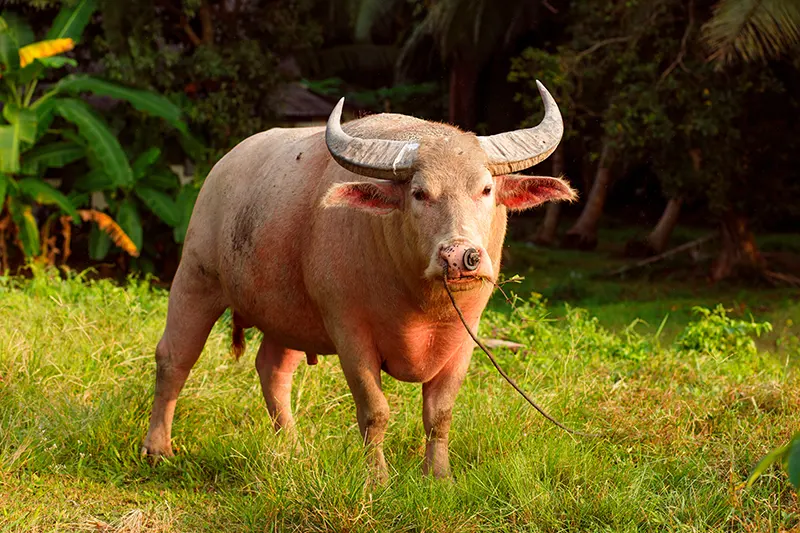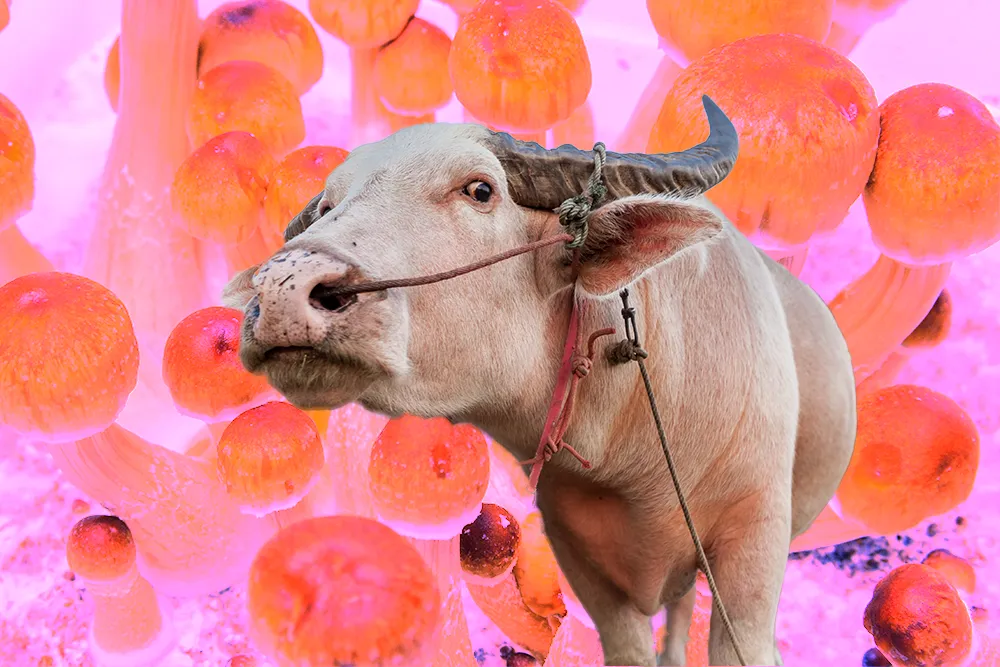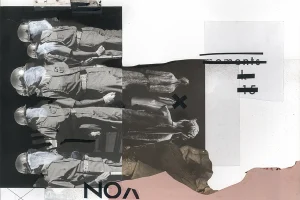Pink Buffalo mushrooms are a variety of Psilocybe cubensis with origins on the island of Koh Samui, off the southern coast of Thailand. Also called Thai Pink Buffalo, PB, or occasionally Hairy Buffalo, Pink Buffalo mushrooms are closely related to the eponymous Koh Samui variety—the mushroom of choice for partygoers during neighboring island Koh Phangan’s famed full moon festivals.
American mycologist John Allen, “Mushroom John,” is usually credited with cataloging Pink Buffalo mushrooms sometime in the late 1990s to early 2000s, and the variety bears resemblance to several other Southeast Asian P. cubensis fungi such as Lipa Yai, Ban Hua, and Cambodian magic mushrooms.
Thai Pink Buffalo Mushroom: Long Story Short
According to one telling, American mycologist John Allen, “Mushroom John,” found Pink Buffalo mushrooms growing on a mound of buffalo dung on the Thai island of Koh Samui after being called into a rice paddy by a “sacred” pink buffalo. (By some accounts, one in ten domestic water buffaloes in Thailand has a distinctive pink hue and it’s locally seen as a sign of good luck, if not sacredness, to spot one.)
This interpretation is supported by an online interview attributed to John Allen describing his discovery of Pink Buffalo mushrooms—with the more mundane caveat that, upon spotting a pink buffalo from the road, Allen cites curiosity, not a spiritual call, that drew him to the paddy. “Of course,” he says in the interview, “this strain has changed a bit since my wild specimen was subsequently domesticated.”
Second Thai pink buffalo tub harvest, 1005g wet
by u/wakedshrooms in shroomers
Yet, when it comes to mushroom lore, it’s not easy to tell fact from fiction. Over two decades ago, a post by the very same John Allen on on Shroomery (MJshroomer) suggests that mycologist Milo Zverino collected this P. cubensis race from Ban Saket, Thailand in 2000. Other spore retailers attribute the “discovery” of Pink Buffalo mushrooms Zverino as well. Regardless, Thai islanders have long known of the mushroom’s psychoactive properties.
Strain Characteristics
The Pink Buffalo Mushroom bears many similarities to other Southeast Asian Psilocybe cubensis varieties. It has slender white or cream stalks that turn an intense blue when bruised (evidence of the presence of the psychoactive compound known as psilocin). Its caps are medium to large in size, and often described as uniform in shape; they range from a light, cinnamon brown to a dark, golden brown with an occasionally purple tinge. Some spore sellers describe a nipple in the cap of the Pink Buffalo mushroom, and photos reveal that it can take on a convex shape if left unharvested.
How to Grow Shrooms Bundle
Take Both of Our Courses and Save $90!
Pink Buffalo spores, often described by myco-enthusiasts as “beautiful” and “exceptional,” range from bright violet, to purplish brown, to purplish black. However, it’s worth noting that physical appearance can vary greatly, even within the same variety of P. cubensis.
“Very few strains consistently look the same way,” Reggie Harris, founder of Oakland Hyphae tells DoubleBlind. “So, in theory, you could have a Pink Buffalo that has the spore characteristics of the Buffalo—but visually, it looks like a Golden Teacher. I would say for 90 percent of cubensis varieties, by the naked eye, it will be difficult to say, you know, that is that.”
Pink Buffalo Strain: Effects, Dosage & Potency
Most mycologists will admit that there’s still a lot we don’t know about psychoactive mushrooms, largely because prohibition drove the culture and the industry underground. Without lab work, it’s often challenging to identify mushrooms or gauge their potency, says Harris, because many of the varieties “have been on the street for so long, and there’s basically no genetic testing for any of this stuff—so it’s kind of whatever somebody tells you it is.”
Genetic testing is the only way to definitively discern one Psilocybe from another—but even with genetic testing, finding differences between cultivated strains is still challenging. Oakland Hyphae hosts the bi-annual Hyphae Cup—mushroom samples are tested by Hyphae Labs and ranked across a number of categories from microdosing to therapeutic applications. They also promote education and conduct research on psilocybin mushrooms. Hyphae Labs co-founder Ian Bollinger and Harris suggest that, in the future, an experiential “mushroom cup” could help parse out some of the experiential differences between mushroom varieties.
READ: Types of Magic Mushrooms: 10 Shroom Strains You Should Know About
Effects
Like all psilocybin-containing mushrooms, a sufficient dose of Pink Buffalo mushrooms will alter your physical sensations, perceptions, and mood. Many people will experience euphoria, visual hallucinations, and spiritual or emotional insights when eating Pink Buffalo mushrooms—perhaps even fostering a sense of healing and wholeness.
Typically, you will start to feel the effects of eating a P. cubensis variety of mushroom within about a half hour, and nausea is possible during the early stages and come-up period. With a moderate dose, the peak of the trip lasts from two to three hours and residual effects will still be felt for several more hours afterwards.
But your set and setting—i.e the thoughts and feelings you take into the trip as well as the environment and people you’re with—will influence the direction and tone of your high. Difficult or disturbing sensations, thoughts, and visuals are all possible, as is nausea and physical discomfort. (Still, psilocybin is considered the safest so-called recreational drug per the 2017 Global Drugs Survey.)
Online descriptions of tripping with Pink Buffalo mushrooms emphasize a warm and euphoric psilocybe high, often accompanied by visuals:
“Pink Buffalo mushrooms plunge you gently in a state of euphoria.” – Shroomok
“Powerful mental high, slight visuals, with less pronounced bodily effects.” – Magic Mycology
“Tripping is soft, smooth and kind.” – Shroomok
But, says Harris from Oakland Hyphae, it’s important to take these kinds of descriptions with a grain of salt—especially when it comes to differentiating the effects between different psilocybe mushrooms.
“Mushrooms aren’t cannabis,” Harris says—citing the fact that people often try to differentiate the effects of mushroom strains or varieties in the same ways they do for cannabis. “With mushrooms, it’s just not that way.”
Dosage
The dry-weight dosing guidelines for P. cubensis mushroom varieties are as follows:
- Microdose: 0.1 – 0.5 grams
- Low Dose: 0.5 – 2 grams
- Moderate Dose: 2 – 3.5 grams
- High Dose: 3.5 – 5 grams and above
However, because the concentration of psychoactive compounds (psilocybin, psilocin, and baeocystin) can vary widely between harvests—and even within mushrooms from the same harvest—dosing by dry weight may not be the most accurate way to gauge the intensity of your trip.
Ian Bollinger, cofounder and Chief Technical Officer of Oakland Hyphae, tells DoubleBlind that in an ideal situation consumers would know how many milligrams of psilocybin their mushrooms contain and dose themselves accordingly—though accurate small-batch testing that’s accessible to average consumers is a little ways off. A few years ago, a German-based company miraculix developed a psilocybin testing kit called QTest, which is one of the only at-home options available for mushroom potency.
READ: You Can Now Buy Shrooms Online—But Should You?

Potency
While some online sources claim that Pink Buffalo is one of the more potent cubensis varieties, Bollinger cites lab analyses finding an “average” amount of psilocybin for a cubensis sample—about six milligrams per gram. (Oakland Hyphae hasn’t yet knowingly tested Pink Buffalo mushrooms.)
However, “Indigenous knowledge is that it typically is a more potent mushroom,” says Harris—highlighting the fact that growing conditions and other factors can influence potency.
How to Grow Pink Buffalo Mushrooms
Pink Buffalo mushroom spores can be purchased legally online through a number of retailers (except in California, Georgia, and Idaho). Cultivating them, however, is only legal in a few jurisdictions; as such, spore prints and spore syringes are typically labeled for the purpose of microscopy.
Pink Buffalo Mushrooms resemble other P. cubensis varieties in that they are considered fairly easy for a beginner or intermediate cultivator to grow and require little in the way of special treatment.

Best Substrates for Pink Buffalo Mushrooms
The Pink Buffalo mushroom does best in a substrate of buffalo or elephant manure, as those are its preferred growing environments in the wild.
“There are a number of people I know that cultivate specifically utilizing buffalo dung and they get great success for that from the Buffalo lineage,” says Bollinger. “So there’s something to be said about organisms and what they’re typically used to growing on.”
The variety, however, is adaptable enough to thrive on a coconut husk substrate or grain spawn bag and has a relatively low risk of contamination.
Best Temperature and Humidity for Growing Pink Buffalo Mushrooms
Pink Buffalo mushrooms prefer a warm and humid environment similar to their Thai island home. During the colonization stage, Pink Buffalo mycelium will develop best when kept at 80-86°F with high humidity. For the fruiting period, decrease the temperature slightly to 68-77°F.
How to Grow Shrooms Bundle
Take Both of Our Courses and Save $90!
Pink Buffalo Mushroom Time from Inoculation to Harvest
Pink Buffalo mushrooms, though quick colonizers, can be a bit slower to fruit than other P. cubensis varieties. From inoculation to first harvest, it typically takes about six weeks.
Pink Buffalo Mushrooms Colonization
Pink Buffalo mycelium colonizes quickly and is considered an “aggressive grower” in the early stages, according to online reports. Though the fruiting phase may slow down a bit—some sources even recommend cold-shocking at this stage to prompt pins to form—it’s frequently described as “productive” and “prolific,” with three or more flushes common. Because it’s fairly easy to grow and has a low risk for contamination, the Pink Buffalo mushroom is a good variety for both beginning and intermediate cultivators. See DoubleBlind’s “How To Grow Mushrooms” guide for more detailed cultivation information.
[Actives] Thai Pink Buffalo growth from 3yo spores stored in freezer
by u/-crazyfrog in MushroomGrowers
Pink Buffalo Mushrooms: Growing vs. Buying
“The biggest pro to cultivating your own is safety,” Jeff Lebowe, Director of the Canadian company Spores Lab, tells DoubleBlind. Through Spores Lab, Lebowe and his team offer mycology services, mushroom genetics, growing equipment, growing supplies, and consultation—including teaching people how to grow mushrooms.
When you purchase spores, “you’re never actually buying anything that’s illegal,” says Lebowe, because the spores and the equipment are lawful to buy and sell. As mentioned above, however, germinating the spores is only decriminalized in some regions, so it’s important to familiarize yourself with laws in your region.
Product safety and proper identification are more good reasons to cultivate at home; that way you can be confident that your supply hasn’t been adulterated or tainted, and that you’re consuming the variety of mushroom you intend to.
“It’s also pretty cool to watch that process happen,” says Lebowe. “It’s slow at the start, but you know, you see your mycelial culture start to take over and colonize a bag of grain. And then you mix that with another substrate and it starts to turn white. Then you see the mushrooms pop up—and actually, the last part of the process is very, very quick. They go from a tiny little pin to a fully grown mushroom in about two days. It’s really cool to see them shoot up like that.”
Disclaimer
Psychedelic decriminalization is happening slowly but surely. But, cultivating psilocybin mushrooms remains illegal in many places. Always consult the laws in your region before engaging with illicit substances. DoubleBlind does not encourage or endorse illegal activities.

DoubleBlind is a trusted resource for news, evidence-based education, and reporting on psychedelics. We work with leading medical professionals, scientific researchers, journalists, mycologists, indigenous stewards, and cultural pioneers. Read about our editorial policy and fact-checking process here.

DoubleBlind Magazine does not encourage or condone any illegal activities, including but not limited to the use of illegal substances. We do not provide mental health, clinical, or medical services. We are not a substitute for medical, psychological, or psychiatric diagnosis, treatment, or advice. If you are in a crisis or if you or any other person may be in danger or experiencing a mental health emergency, immediately call 911 or your local emergency resources. If you are considering suicide, please call 988 to connect with the National Suicide Prevention Lifeline.




